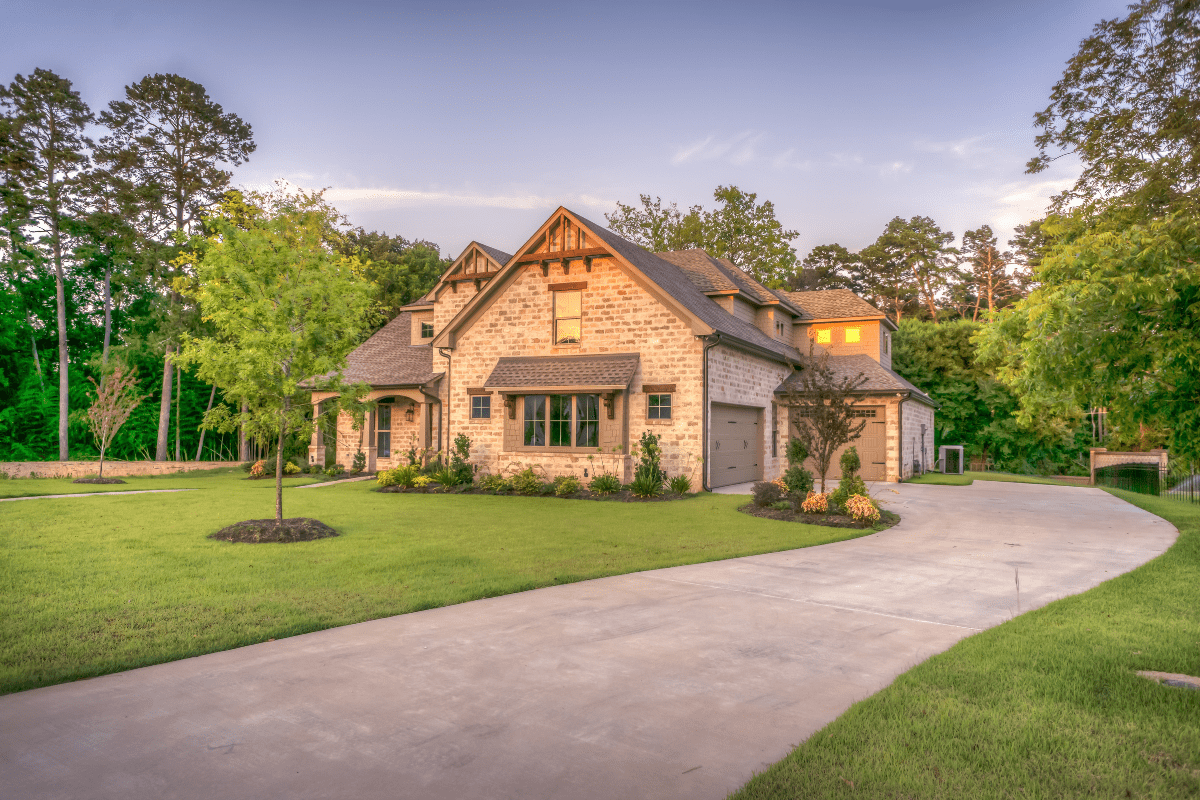Ever driven through a Texas neighborhood and wondered why some houses look like they belong on a ranch while others seem straight out of a Spanish telenovela? You're not alone. Texas residential architecture tells the story of cowboys, German settlers, oil barons, and tech entrepreneurs, all written in limestone, stucco, and good old-fashioned brick.
Understanding the Texas "Big Three"
Before we dive into turrets and dog-trots (yes, that's a real architectural term), let's start with the heavy hitters. These three styles dominate Texas neighborhoods from Amarillo to Brownsville, and chances are, you're living in one right now.
Ranch style: The suburban superhero
The ranch home is basically the Toyota Camry of Texas architecture… reliable, everywhere, and surprisingly practical. If your house sprawls across your lot like a cat in a sunbeam and you haven't climbed stairs in years, congratulations, you probably own a ranch.
These single-story wonders took over Texas suburbs faster than fire ants at a picnic. Born in the 1920s from Spanish Colonial haciendas (fancy ancestors, right?), ranch homes hit their stride after World War II when returning veterans needed affordable housing and apparently had strong opinions about stairs.
How to spot a ranch home:
- One story that goes on forever
- Roof so low it's practically horizontal
- Windows big enough to drive through
- L-shaped or rectangular footprint
- Attached garage (because Texas)
- Sliding glass doors to the patio
Original ranch homes were modest affairs, typically 1,000 to 1,500 square feet. But this is Texas, where everything's bigger, so modern versions can sprawl past 3,000 square feet. At current Texas home prices hovering around $335,000 to $356,000, ranch homes offer solid value. Though if you want one of those fancy "ranch estates" with a pool the size of Rhode Island, prepare to shell out over a million.
The genius of ranch design in Texas? Those wide overhangs aren't just for looks… they keep the brutal summer sun from turning your living room into a convection oven. Add in the covered patios perfect for barbecuing in January (because Texas weather is weird like that), and you've got a house that actually makes sense.
Hill Country style: When Germans met limestone
Nothing says "Texas" quite like a Hill Country home, unless maybe it's a cowboy hat or breakfast tacos. These beauties stand out like a well-dressed German at a rodeo, which is basically their origin story.
When German settlers arrived in the 1830s-1860s, they brought their building know-how but quickly realized Texas limestone was way more available than German timber. The result? Those gorgeous white stone houses with dark wood trim that make every HGTV host swoon.
The real genius move was the "dog-trot" design… an open breezeway between two sections of the house. Before air conditioning existed, this created natural cooling that actually worked. Take that, modern technology.
Classic Hill Country features:
- White limestone walls (thick as a linebacker)
- Dark timber accents
- Standing-seam metal roofs
- Two stories with gabled roofs
- Smaller, gridded windows
- Stone chimneys
Today's Hill Country homes command a 10-20% premium over average prices in Central Texas. Why? Because they're basically the architectural equivalent of a luxury pickup truck… rugged, practical, and undeniably Texan. Modern versions keep the charm while adding conveniences like geothermal cooling and rainwater collection systems (because drought is also undeniably Texan).
Spanish Colonial and Mediterranean: Old World meets New World
If your house looks like it could host a telenovela filming, you've got Spanish or Mediterranean influence. These styles arrived with Spanish colonists way back in the 1680s and have been making Texas neighborhoods prettier ever since.
The revival period from 1915-1940 gave us entire neighborhoods of these beauties, especially in San Antonio where architect Atlee B. Ayres basically went on a Spanish Colonial spree. Monte Vista and Olmos Park still showcase his work, making other neighborhoods jealous with their fancy arches and courtyards.
Spanish/Mediterranean must-haves:
- Stucco exteriors (the original energy saver)
- Red clay barrel tile roofs
- Arched everything
- Wrought iron details
- Interior courtyards
- Thick walls (12-18 inches!)
These homes weren't just pretty… they were smart. That stucco reflects heat like a boss, tile roofs create cooling air pockets, and courtyards provide shaded outdoor spaces perfect for sipping margaritas. Er, I mean, contemplating architecture.
In today's market, Mediterranean styles command 15-25% premiums in upscale neighborhoods. Sure, maintenance can be pricey (those tiles don't replace themselves), but can you really put a price on living in what looks like a vacation resort?
Beyond the Big Three: Texas's Other Architectural Personalities
Not every Texas home fits neatly into the ranch-limestone-stucco trifecta. The state's got more architectural variety than a Houston food truck park.
Contemporary and modern: When less is more (except size)
Contemporary Texas homes are what happens when minimalism meets "everything's bigger in Texas." These geometric beauties started appearing in the 1920s-1930s when pioneers like David Williams and O'Neil Ford decided European modernism needed a Texas makeover.
Picture floor-to-ceiling windows (because privacy is overrated), flat roofs (because who needs attics?), and material mixing that would make a DJ jealous. Steel from the oil industry, limestone from local quarries, and enough glass to make birds nervous… it's all fair game.
Modern home markers:
- Clean geometric lines
- Mixed materials everywhere
- Massive windows
- Flat or barely-there roofs
- Open floor plans
- Sustainable features
In trendy neighborhoods like Austin's Zilker or Dallas's Preston Hollow, these babies run $300-500 per square foot. Tech professionals and design enthusiasts eat them up faster than breakfast tacos at a startup meeting.
Craftsman bungalows: Cozy meets character
Found clustered in historic neighborhoods like Dallas's M Streets, Austin's Hyde Park, and Houston's Heights, Craftsman homes are basically the architectural equivalent of your favorite worn-in boots… comfortable, full of character, and impossible to replicate.
Built between 1905-1930, these homes celebrated handcrafted details when that actually meant something. Texas Craftsman homes adapted the national style with bigger porches (because Texas summers) and local materials like Texas pine.
The built-in furniture and woodwork in these homes makes modern IKEA shoppers weep with envy. Market prices range from $300,000 to $1.2 million, though restoration costs can exceed what it originally cost to build the entire neighborhood.
Victorian beauties: When more was more
Victorian homes are what happens when architects discover unlimited decorative options and zero chill. Built during Texas's post-Civil War boom (1870-1900), these ornate beauties required skilled craftsmen and deep pockets.
Galveston hosts one of America's largest Victorian collections, probably because after surviving hurricanes, a little decorative trim seems like no big deal. San Antonio's King William neighborhood also showcases these architectural showoffs.
Victorian variety pack:
- Turrets (because why not?)
- Asymmetrical everything
- Decorative trim overload
- Bay windows
- Wraparound porches
- Paint colors that make HOAs nervous
Maintaining a Victorian is like dating a high-maintenance partner… expensive, demanding, but undeniably gorgeous. Those multiple rooflines and historic preservation requirements mean you'll get to know your contractor really well.
How Geography Shapes Texas Homes
Texas is huge (shocking, I know), and different regions developed their own architectural personalities based on climate, materials, and the questionable decisions of early settlers.
East Texas: Where the South begins
East Texas architecture borrowed heavily from the Deep South, probably because humidity recognizes no state borders. Traditional dog-run houses provided cross-ventilation before AC, while raised foundations kept homes above flood levels and let air circulate underneath.
Greek Revival influences show up in symmetrical facades and formal columns, proving that even in the piney woods, folks wanted to feel fancy.
West Texas: Desert dwelling done right
Out where tumbleweeds outnumber people, adobe construction makes perfect sense. Those thick mud-brick walls provide natural insulation against temperature swings that would make a thermostat cry.
Modern West Texas homes keep the low profiles and earth tones while upgrading to materials that don't dissolve in the occasional rainstorm.
Gulf Coast: Built to survive
Coastal architecture isn't playing around. When building codes require 130-190+ mph wind resistance, you get homes that look like they're ready for battle.
Hurricane-ready features:
- Elevated construction
- Impact-resistant windows
- Hip roofs (fewer edges to catch wind)
- Reinforced everything
- Pilings deeper than family secrets
Central Texas: Limestone country
Beyond the Hill Country style, Central Texas loves its limestone like Texans love football. German Fachwerk (half-timbering) techniques pop up in Fredericksburg and New Braunfels, creating homes that look like they're perpetually hosting Oktoberfest.
Reading the Market: What's Hot in Texas Homes
Current Texas real estate trends show ranch homes still dominating suburban markets (surprise, surprise), while contemporary designs are taking over city centers faster than tech companies buying up real estate.
Mediterranean and Hill Country styles command the highest premiums at 15-25% above average, proving that sometimes the old ways are the profitable ways. Traditional styles hover right around market averages, making them the reliable middle children of Texas architecture.
Emerging trends to watch:
- Natural modern design
- Climate-responsive features
- Smart home integration
- Sustainability focus
- Modern barndominiums
That last one… barndominiums… deserves special mention. These metal-clad structures combining living space with workshops are basically Texas's way of saying "why choose?" to the house-versus-garage debate.
Your Home Style Identification Cheat Sheet
Still confused about what style your house is? Here's your quick reference guide:
Start with the roofline. Low and lazy? Probably ranch or contemporary. Steep and dramatic? Victorian or Craftsman. Covered in clay tiles? Spanish influence all the way. Metal? Hill Country heritage.
Check the materials next. Stucco plus tile equals Spanish vibes. Limestone means Hill Country roots. Enough decorative woodwork to stock a lumber yard? Victorian. Mixed modern materials? Contemporary.
Look at the layout. Single-story spread screams ranch. Two-story limestone shouts Hill Country. Asymmetrical with more angles than a geometry textbook? Victorian's your answer.
Window styles tell stories too. Large horizontal windows mean ranch. Arched openings whisper Spanish influence. Gridded patterns suggest Hill Country or Craftsman. Floor-to-ceiling glass? Contemporary all day.
Don't forget historical context. Ranch homes peaked in the 1950s-1970s. Craftsman dominated 1905-1930. Spanish Revival flourished 1915-1940. Contemporary has been evolving since the 1920s, like a architectural shape-shifter.
What's Next for Texas Architecture?
Texas architecture keeps evolving faster than our ability to categorize it. Climate change is pushing storm resistance and energy efficiency from "nice to have" to "absolutely necessary." The aging population wants single-story accessibility (ranch revival, anyone?), while young professionals demand smart homes smarter than they are.
New residents keep arriving with fresh ideas but quickly embrace Texas traditions, creating hybrid styles that would confuse architectural historians. Historic preservation battles innovation in established neighborhoods, while new developments experiment with sustainable updates to classic designs.
The Bottom Line on Texas Homes
Whether you're house hunting, curious about your own home's heritage, or just trying to win a neighborhood architecture argument, understanding Texas home styles connects you to the state's rich history. Each style represents generations of people figuring out how to live comfortably in a state that can't decide if it wants to be a desert, a swamp, or a wind tunnel.
From German settlers building with limestone to modern architects pushing sustainable boundaries, Texas homes tell stories of adaptation, innovation, and occasionally, questionable decorative choices. But hey, that's what makes driving through Texas neighborhoods more interesting than scrolling through Pinterest.
So next time you spot a house and wonder about its style, you'll know whether you're looking at a ranch relaxing in the suburbs, a Hill Country beauty showing off its limestone, or a Victorian dame refusing to tone it down. Because in Texas architecture, like everything else in the state, there's always a bigger story behind that facade.





